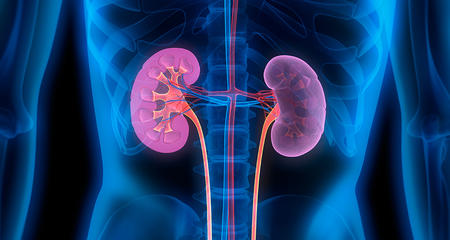Cushing’s disease occurs when the pituitary gland releases too much of the hormone, adrenocorticotropic hormone (ACTH), thus triggering the adrenal gland to overstimulate the production of cortisol, a stress hormone. Cushing’s disease is a form of Cushing’s syndrome
Cushing’s syndrome occurs when the body is exposed to too much of the hormone cortisol. It is a serious and unusual hormonal disorder, so patient care is best provided by endocrinologists highly experienced in diagnosing and treating Cushing’s syndrome.
Causes of Cushing’s Syndrome
The most common cause of Cushing’s syndrome is cortisol-like steroid medication, such as prednisone. These medications may be prescribed at a high dose for a long period of time to treat lupus, asthma and other conditions. Genetically, some patients are more sensitive to cortisol-like steroids than others.
Tumors or nodules in or near the pituitary and adrenal glands may also be the cause. These conditions include:
- Cushing’s disease. Cushing’s disease is associated with non-cancerous and usually small pituitary gland tumors that secrete adrenocorticotropic hormone (ACTH). Too much ACTH stimulates the adrenal glands and causes them to overproduce cortisol.
- Ectopic ACTH syndrome. This condition is associated with cancerous or noncancerous tumors that develop outside the pituitary and adrenal glands, most often in the lungs, and produce excess ACTH.
- Cortisol-producing adrenal tumors. Adrenal tumors (adrenal nodules) can also produce too much cortisol. Symptoms can start out mild, so they may be overlooked for many years.
Symptoms of Cushing’s Disease and Syndrome
At proper levels, cortisol helps the body respond to stress, regulate important functions in the body and convert fat, carbohydrates and proteins into energy. Too much cortisol can lead to Cushing’s disease and syndrome, causing symptoms including:
- Weight gain in the neck, face and upper body
- Round, full face (moon facies)
- Fatigue
- Flushing in the face
- Thin skin with easy bruising
- Acne and skin problems
- Purple stretch marks on the stomach, upper arms, thighs and breasts
- Diabetes mellitus
- High blood pressure
- Osteoporosis
- Excess facial hair and fewer menstrual periods in women
- Decreased libido or erection difficulties in men
- Infertility in both men and women
- Muscle weakness
- Depression
- Significant problems with memory and thinking
- Headaches
Diagnosing Cushing’s Syndrome
Cushing's disease and syndrome are diagnosed by physicians by measuring the levels of cortisol in the patient's body. This can be done through standard blood and urine tests, or through specialized tests. It usually takes a combination of multiple tests to make this diagnosis and determine the cause of cortisol excess.
- Cortisol and ACTH labs measure the amount of hormones in the blood.
- A salivary cortisol test is a screening test for Cushing’s Disease and Syndrome that involves measuring levels of cortisol in saliva between 11:00 p.m. and midnight. People with Cushing’s have an elevated level of cortisol late in the evening, when it should otherwise decrease. Saliva is collected in an absorbent material, which is then placed in a small vial and sent to the lab for analysis. If the test is positive, it is repeated and other tests are done to confirm a Cushing’s diagnosis. The test was developed in the 1990s by Froedtert & the Medical College of Wisconsin endocrinologist James Findling, MD.
- Dexamethasone suppression tests determine whether cortisol is appropriately suppressed when given a dose of dexamethasone. This test is done when it is suspected that the body is producing too much cortisol. During the test, a patient receives dexamethasone, and the patient’s cortisol levels are measured the next morning.
- Magnetic resonance imaging (MRI), if ACTH-dependent Cushing's in excess cortisol is confirmed by biochemical testing, other tests need to be conducted to pinpoint the cause and determine the most appropriate treatment. An MRI may be recommended to scan for ACTH-secreting tumors that cause Cushing’s, most of which are found in the pituitary. If the MRI is inconclusive, additional tests may be requested.
- Inferior petrosal sinus sampling (IPSS) is an invasive procedure to assist in determining if the elevated levels are related to a pituitary tumor or a tumor somewhere else in the body. IPSS can also be utilized to assist in determining which side of the pituitary gland the tumor can be found.
Cushing's Disease and Syndrome Treatments
The best course of treatment for Cushing’s disease, ectopic ACTH syndrome and other forms of Cushing’s syndrome depends on the cause of the condition.
Medications
When Cushing’s syndrome is caused by an excessive level of cortisol due to medications, reducing the dosage may be an option. If not, treatment involves symptom relief and medication to help treat complications of cortisol excess.
Patients with Cushing’s disease or syndrome may also receive treatment for specific complications, such as medication for high blood pressure, diabetes and depression.
Pituitary Tumor Surgery
When Cushing’s disease or syndrome is caused by a pituitary tumor, the most effective treatment is surgery. Tumors may recur, however, so an annual assessment of cortisol secretion is important. If pituitary surgery does not resolve the symptoms or if the tumor recurs, several treatment options are available, including a repeat operation, radiation therapy and medication.
Adrenal Tumor Surgery
If an adrenal gland tumor is the cause, the most effective treatment is the removal of the gland through minimally invasive surgery.
Blogs, Patient Stories, Videos and Classes





